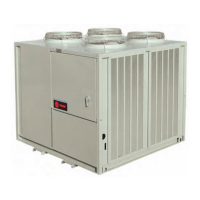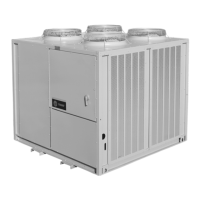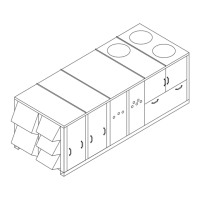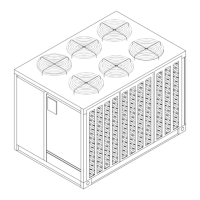CAUJ-SVX01E-EN
45
Pre-Start
Use the checklist provided below in conjunction with
the “General Unit Requirement” checklist” to ensure
that the unit is properly installed and ready for
operation. Be sure to complete all of the procedures
described in this section before starting the unit for the
first time.
WWAARRNNIINNGG
HHaazzaarrddoouuss VVoollttaaggee!!
FFaaiilluurree ttoo ddiissccoonnnneecctt ppoowweerr bbeeffoorree sseerrvviicciinngg ccoouulldd
rreessuulltt iinn ddeeaatthh oorr sseerriioouuss iinnjjuurryy..
DDiissccoonnnneecctt aallll eelleeccttrriicc ppoowweerr,, iinncclluuddiinngg rreemmoottee
ddiissccoonnnneeccttss bbeeffoorree sseerrvviicciinngg.. FFoollllooww pprrooppeerr
lloocckkoouutt//ttaaggoouutt pprroocceedduurreess ttoo eennssuurree tthhee ppoowweerr
ccaann nnoott bbee iinnaaddvveerrtteennttllyy eenneerrggiizzeedd..
• Turn the field supplied disconnect switch, located
upstream of the unit, to the “Off” position.
• Turn the “System” selection switch (at the Remote
Panel) to the “Off” position and the “Fan” selection
switch (if applicable) to the “Auto” or “Off” position.
• Check all electrical connections for tightness and
“point of termination” accuracy.
• Verify that the condenser airflow will be
unobstructed.
• Check the condenser fan blades. Ensure they rotate
freely within the fan orifices and are securely
fastened to the fan motor shaft.
NNOOTTIICCEE
CCoommpprreessssoorr DDaammaaggee!!
EExxcceessssiivvee lliiqquuiidd aaccccuummuullaattiioonn iinn tthhee ssuuccttiioonn lliinneess
ccoouulldd rreessuulltt iinn ccoommpprreessssoorr ddaammaaggee..
DDoo nnoott aallllooww lliiqquuiidd rreeffrriiggeerraanntt ttoo eenntteerr tthhee ssuuccttiioonn
lliinnee..
• Verify that all compressor service valves, discharge
service valves, and liquid line service valves are
back seated on each circuit.
IImmppoorrttaanntt:: After liquid line service valves are fully
opened (back seated), close just 1/4 turn
to allow for fan pressure control (4S7,
4S8) operation.
• Check the condenser coils. They should be clean
and the fins should be straight. Straighten any bent
coil fins with an appropriate sized fin comb.
• Inspect the interior of the unit for tools and debris.
System Evacuation Procedures
NNOOTTIICCEE
OOppeerraattiinngg UUnnddeerr VVaaccuuuumm!!
FFaaiilluurree ttoo ffoollllooww tthheessee iinnssttrruuccttiioonnss wwiillll rreessuulltt iinn
ccoommpprreessssoorr ffaaiilluurree..
DDoo nnoott ooppeerraattee oorr aappppllyy ppoowweerr ttoo tthhee ccoommpprreessssoorr
wwhhiillee uunnddeerr aa vvaaccuuuumm..
Each refrigeration circuit for split system applications
must be evacuated before the unit can be started. Use a
rotary type vacuum pump capable of pulling a vacuum
of 100 microns or less. Verify that the unit disconnect
switch and the system control circuit switches are
“OFF”.
The oil in the vacuum pump should be changed each
time the pump is used with a high quality vacuum
pump oil. Before using any oil, check the oil container
for discoloration which usually indicates moisture in
the oil and/or water droplets. Moisture in the oil adds to
what the pump has to remove from the system, making
the pump inefficient.
When connecting the vacuum pump to a refrigeration
system, it is important to manifold the vacuum pump to
both the high and low side of the system (liquid line
access valve and suction line access valve). Follow
pump manufacturer’s directions for proper methods of
using vacuum pump.
The lines used to connect pump to the system should
be copper and the largest diameter that can practically
be used. Using larger line sizes with minimum flow
resistance can significantly reduce evacuation time.
Rubber or synthetic hoses are not recommended for
system evacuation. They have moisture absorbing
characteristics which result in excessive rates of
evaporation, causing pressure rise during standing
vacuum test. This makes it impossible to determine if
system has a leak, excessive residual moisture, or a
continual or high rate of pressure increase due to
hoses.
An electronic micron vacuum gauge should be
installed in the common line ahead of the vacuum
pump shutoff valve, as shown in Figure 32, p. 51. Close
Valves B and C, and open Valve A.
Start vacuum pump. After several minutes, the gauge
reading will indicate the maximum vacuum the pump
is capable of pulling. Rotary pumps should produce
vacuums of 100 microns or less.
Open Valves B and C. Evacuate the system to a
pressure of 300 microns or less. As vacuum is being
pulled on the system, it may appear that no further
vacuum is being obtained, yet the pressure is high. To
facilitate the evacuation process, it is recommended
that the vacuum be “Broken”.

